Parking lot
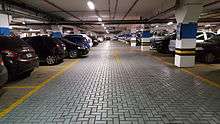
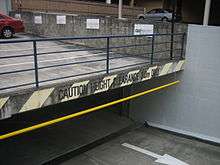
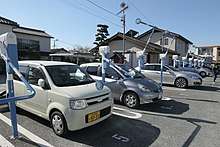
A parking lot (American English) or car park (British English), also known as a car lot, is a cleared area that is intended for parking vehicles. Usually, the term refers to a dedicated area that has been provided with a durable or semi-durable surface. In most countries where cars are the dominant mode of transportation, parking lots are a feature of every city and suburban area. Shopping malls, sports stadiums, megachurches and similar venues often feature parking lots of immense area. See also multistorey car park.
Parking lots tend to be sources of water pollution because of their extensive impervious surfaces. Most existing lots have limited or no facilities to control runoff. Many areas today also require minimum landscaping in parking lots to provide shade and help mitigate the extent of which their paved surfaces contribute to heat islands. Many municipalities require a minimum number of parking spaces, depending on the floor area in a store or the number of bedrooms in an apartment complex. In the United States, each state's Department of Transportation sets the proper ratio for disabled spaces for private business and public parking lots. Various forms of technology are used to charge motorists for the use of a parking lot. Modern parking lots use a variety of technologies to help motorists find unoccupied parking spaces, retrieve their vehicles, and improve their experience.

Parking minimums and maximums
In North America, parking minimums are requirements, as dictated by a municipality’s zoning ordinance, for all new developments to provide a set number off-street parking spots. These minimums look to cover the demand for parking generated by said development at the peak times.[1] Thus different land uses, whether they be commercial, residential or industrial, have different requirements to meet when deriving the number of parking spots needed.
U.S. urban planners use Parking Generation Rates, a guidebook of statistical data from the Institution of Transportation Engineers, to source parking minimums. In these reports, the ITE define a type of land use's Parking Generation through an observational study. Parking Generation is statistically found by land use's, average generation rate, the range of generation rates, the subsequent standard deviation, and the total number of studies. To determine the parking generation rate of a building the ITE divides the peak parking observed by the floor area per 1000 square feet. This process is done by various studies to find the range. In the case of ITE studies, the observation of a single site multiple times is considered a stand-alone study. Then the average of the range is used to determine the average parking generation rate of a land use.[2] This handbook is updated every 5 years to determine the demand for parking for specific land uses. Parking Generation Rates provided by the ITE doesn’t explicitly state what parking minimums should be, but rather is just a collection of statistical data for urban planners to interpret and use for at their own volition. Regardless, ITE’s Parking Generation has been an influential factor In most North American cities in the adoption parking ratios, according to land use, to determine the minimum spots required by new developments.
Parking Generation, regardless of its widespread use in North American cities, is disputed as a tool to determine parking minimums due to its questionable statistical validity. Statistical significance is a major qualm with Parking Generations due to the oversimplification of how the parking generation rate is derived. Peak parking observed by ITE doesn’t take into account the price of parking in relation to the number of parked cars.[3] Thus the demand at any given time for parking is always high because it is oversupplied and underpriced. Thus the calculation for the parking generation rate of a land use some would argue are inflated.
Adoption of parking minimums by municipalities, base on ratios from Parking Generation had a substantial affect on urban form. This can be seen in the lack of density characterized by the suburbanization of North America post-World War II.[4] The growth of the car industry and car culture, in general, has much to do with the mass movement of the middle-class away from urban centers and exterior of the city in single family detached homes. As populations grew and density dissipated automobiles became the main mode of transportation. Thus insuring that new developments insured off-street park became a necessity.
Parking minimums are also set for parallel, pull-in, or diagonal parking, depending on what types of vehicles are allowed to park in the lot or a particular section of it. Parking minimums initially took hold in the middle of the last century, as a way to ensure that traffic to new developments wouldn't use up existing spaces.[5]
Big cars may not fit properly in assigned parking spaces, creating issues with entering or leaving the car or blocking adjacent parking spaces.
In Europe, parking maximums are more common. As a condition of planning permission for a new development, the development must be designed so that a minimum percentage of visitors arrive by public transport. The number of parking places in the development is limited to a number less than the expected number of visitors.[6]
Parking and urban planning
The effect of large scale parking in-city has long been contentious. Elimination of historic structures in favor of garages or lots led to historical preservation movements in many cities. The acreage devoted to parking is widely seen as disrupting a walkable urban fabric, maximizing convenience to each individual building, but eliminating foot traffic among them. Large paved areas have been called "parking craters", "parking deserts", and similar terms, emphasizing their "depopulated" nature and the barriers they can create to walking movement. Due to a recent trend towards more livable and walkable communities, parking minimums (policies requiring each building to have at least a minimum number of parking spaces) have been criticized by both livable streets advocates[7] and developers alike. For a time, the British government recommended that local councils should establish maximum parking standards to discourage car use.[8] American cities such as Washington, DC, are now considering removing parking minimums as a way to add more housing for residents while encouraging the use of public transit.[9]
Parking lots designed specifically for bicycle parking are also becoming more prevalent in response to increased environmental and health consciousness. These may include bicycle parking racks and locks, as well as more modern technologies for security and convenience.[10] For instance, a growing number of bicycle parking lots in Tokyo include automated parking systems.[11][12]
Legal issues
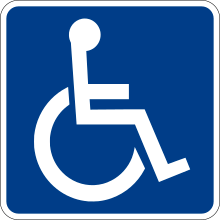
Sweden and Denmark

In Sweden and Denmark, there are legally two types of car parking, either on streets and roads, or on private land. A parking violation on streets is a traffic crime, resulting in fines. A parking violation on private land (also if owned by the city) is a contract violation and gives additional parking fee (Swedish: kontrollavgift = check fee). The difference is small for the car owner and the owner is always responsible.
United Kingdom
The United Kingdom has two types of car parking: either on public or on private land. The difference is that the police will investigate any reported accident on public land but have no legal obligation and will not do so on private land. Public road is defined by the Road Traffic Act 1972 and (Amendment) Regulations 1988 S.I. 1988/1036[13] as: "Road", in relation to England and Wales, means any highway and any other road to which the public has access, and includes bridges over which a road passes. There is also a House of Lords judgment on this matter.[14]
Civil enforcement officers enforce parking restrictions on public, council-run car parks. These include failure to purchase a ticket as payment (if available)/not parking in a marked bay/other offences.
United States
In the United States, each state's Department of Transportation sets the proper ratio for disabled spaces for private business and public parking lots. Certain circumstances may demand more designated spaces. These reserved spaces are mandated by the Americans with Disabilities Act Accessibility Guidelines.[15]
Those in possession of the proper ID tags or license plates are also free from parking violation tickets for running over their metered time or parking in an inappropriate place, as some disabilities may prohibit the use of regular spaces. Illegally parking in a disabled parking space or fraudulent use of another person's permit is heavily fined.
Payment
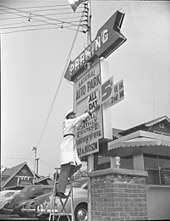
Various forms of technology are used to charge motorists for the use of a parking lot.
Boom gates are used in many parking lots. A customer arrives to the entry ticket machine by vehicle, presses the ticket request push button, takes a ticket - which raises the barrier - and enters the parking lot. To exit the lot, the customer presents the ticket to a cashier in a booth at the exit and tenders payment, after which the cashier opens the boom gate.
In 1954, the first automated parking lots were built where, for a monthly fee, a driver with a magnetic key card could enter and exit the parking lot by raising and lowering the boom.[16]
A more modern system uses automatic pay stations, where the driver presents the ticket and pays the fee required before returning to their car, then drives to the exit terminal and presents the ticket. If the ticket has not been paid for, the boom barrier will not raise, which will force the customer to either press the intercom and speak to a staff member, or reverse out to pay at the pay station or cashier booth.
At the parking lots of some major airports in the United States, a driver can choose to swipe a credit card at the entry ticket dispenser instead of taking a ticket. When the driver swipes the same credit card at the exit terminal upon leaving the lot, the applicable parking fee is automatically calculated and charged to the credit card used.
In some parking lots, drivers present their tickets to and pay the cashiers at a separate cashier's office or counter (which are often located elsewhere from the entrances and exits of carparks). Such cashier's offices are called shroff offices or simply shroff in some parking lots in Hong Kong and other parts of East Asia influenced by the Hong Kong usage. If a ticket has not been paid, the barrier will not raise. In recent years, cashiers and shroff officers have often been replaced with automated machines. Another variant of payment has motorists paying an attendant on entry to the lot, with the way out guarded by a one-way spike strip that will only allow cars to exit.
Parking meters can also be used, with motorists paying in advance for the time required for the bay they are parked in. Pango (a play on "pay and go"[17]), a company founded in Israel in 2007, created a mobile app that allows users to both find and pay for available metered parking; the app can also be used to pay for garage parking.[17] Users' accounts are linked to a payment method, and the system remembers where a vehicle is parked and allows users to share a parking session with Facebook friends. Users may also, for a nominal monthly fee per registered car, subscribe to reminders that text alerts shortly before metered time expires,[18] and in some municipalities, users may buy additional metered time via cellphone. Philadelphia, encourages parking space turnover by charging escalating parking fees when metered time is added.[19][20] Another app, Streetline, whose primary purpose is to help motorists find open parking spots using their smartphones, includes a timer, so users can get back to a parking meter before it expires, and a filter that lets users choose between on-street and off-street parking spaces; it also connects to the phone's camera so a user can take a photograph of their car.[21]
Other lots operate on a pay and display system, where a ticket is purchased from a ticket machine and then placed on the dashboard of the car. Parking enforcement officers patrol the lot to ensure compliance with the requirement.
Similar to this is the system where the parking is paid by the mobile phone by sending an SMS message which contains the license plate number. In this case, the virtual cashier books the car and the time when the message is sent, and later a new SMS message must be sent whenever the time is due. The actual payment is then made via the mobile phone bill.
Since 1978 in the United Kingdom, it has been possible to pre-book parking with specialist companies, such as BCP. This is prevalent at all airports, major ports and cities.
Technology

Modern parking lots use a variety of technologies to help motorists find unoccupied parking spaces using parking guidance and information system, retrieve their vehicles, and improve their experience. This includes adaptive lighting, sensors, indoor positioning system (IPS) and mobile payment options. The Santa Monica Place shopping mall in California has cameras on each stall that can help count the lot occupancy and find lost cars.[22]
In outdoor parking lots, GPS can be used to remember the location of a vehicle (some apps saves location automatically when turning off the car when a smartphone breaks communication with a vehicle's Bluetooth connection). In indoor parking lots, one option is to record one's Wi-Fi signature (signal strengths observed for several detectable access points) to remember the location of a vehicle.[23]
Online booking technology service providers have been created to help drivers find long-term parking in an automated manner, while also providing significant savings for those who book parking spaces ahead of time. They use real-time inventory management checking technology to display parking lots with availability, sorted by price and distance from the airport.
There are mobile apps providing services for the reservation of longterm parking lot spaces similar to online or aggregate parking facility booking services. Some longterm parking mobile apps also have turn-by-turn maps to locate the parking lot, notably US and UK based ParkJockey.
Environmental considerations
Water pollution
Parking lots tend to be sources of water pollution because of their extensive impervious surfaces. Virtually all of the rain (minus evaporation) that falls becomes urban runoff. To avoid flooding and unsafe driving conditions, the lots are built to effectively channel and collect runoff.[24] Parking lots, along with roads, are often the principal source of water pollution in urban areas.[25]
Motor vehicles are a constant source of pollutants, the most significant being gasoline, motor oil, polycyclic aromatic hydrocarbons (PAHs), and heavy metals. (PAHs are found in combustion byproducts of gasoline, as well as in asphalt and coal tar-based sealants used to maintain parking lots.) Many parking lots are also significant sources of trash which ends up in waterways.[26]
Treatment of pollution : Traditionally, the runoff has been shunted directly into storm sewers, streams, dry wells or even sanitary sewers. However, most larger municipalities now require construction of stormwater management facilities for new lots. Typical facilities include retention basins, infiltration basins and percolation trenches.[27] Some newer designs include bioretention systems, which use plants more extensively to absorb and filter pollutants. However, most existing lots have limited or no facilities to control runoff.
Alternative paving materials : An alternative solution today is to use permeable paving surfaces, such as brick, pervious concrete, stone, special paving blocks, or tire-tread woven mats. These materials allow rain to soak into the ground through the spaces inherent in the parking lot surface. The ground then may become contaminated in the surface of the parking lot park, but this tends to stay in a small area of ground, which effectively filters water before it seeps away. This can however create problems if contaminants seep into groundwater, especially where there is groundwater abstraction 'downstream' for potable water supply.
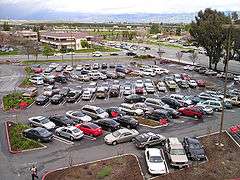
Landscaping
Many areas today also require minimum landscaping in parking lots. This usually principally means the planting of trees to provide shade. Customers have long preferred shaded parking spaces in the summer, but parking lot providers have long been antagonistic to planting trees because of the extra cost of cleaning the parking lots.
Paved surfaces contribute to heat islands in two ways. The first is through excessive accumulation of heat. Dark materials and the enclosed canyons created by city buildings trap more of the sun's energy. The reflection rate of paving compared to natural surfaces is important as higher reflectance means cooler temperatures. Black pavements, the hottest, have solar reflectances of 5 to 10 percent. Lighter pavements have solar reflectance rates of 25 percent or higher. Reflectance values for soils and various types of vegetation range from 5 to 45 percent. The second cause of heat islands is the low moisture content of paving and building materials. Such materials are watertight, so no moisture is available to dissipate the sun's heat through evaporation.[28]
Tree planting has been shown to significantly reduce temperatures in open, paved areas. In one study in Alabama, daytime summer temperatures of 120°degrees(F) were recorded in the centre of a bare parking lot, whereas where a small island of trees was present, temperatures only reached 89°degrees(F). It also found that a further 1°degree(F) temperature reduction could be obtained for every additional canopy tree planted.[29]
Land usage
A parking lot needs fairly large space, around 25 square meters, or 270 square feet per parking spot. This means that lots usually need more land area than for corresponding buildings for offices or shops if most employees and visitors arrive by car. This means covering large areas with asphalt.
Services
Some lots have charging stations for battery vehicles. Some regions with especially cold winters provide electricity at most parking spots for engine block heaters, as antifreeze may be inadequate to prevent freezing.
See also
| Wikimedia Commons has media related to Carpark. |
- Automated parking system
- Automatic number-plate recognition (ANPR)
- Automatic vehicle location
- British Parking Association
- Charging station
- Green parking lot
- Indoor positioning system (IPS)
- Multi-storey car park
- Park and ride
- Parking meter
- Parking space
- Permeable paving
- Radio-frequency identification (RFID)
- Road surface marking
- Vehicle location data
References
- ↑ Shoup, Donald (9 December 1999). "The Trouble With Minimum Parking Requirements" (PDF). Retrieved 5 September 2017.
- ↑ Parking Generation. ITE. 07/10. ISBN 1-933452-55-2. Check date values in:
|year=(help) - ↑ SHOUP, DONALD C. "Truth in Transportation Planning" (PDF). Journal of Transportation and Statistics. 66: 1–6.
- ↑ Kwak, Nancy (2015). A World of Homeowners. University of Chicago Press. pp. 10–23. ISBN 9780226282497.
- ↑ Vanderbilt, Tom (18 September 2015). "There's No Such Thing as Free Parking". Archived from the original on 3 February 2012 – via Slate.
- ↑ "Parking standards for new developments". www.wycombe.gov.uk. Archived from the original on 16 January 2018. Retrieved 8 May 2018.
- ↑ Fried, Ben (20 August 2008). "How to Fix Off-Street Parking Policy, Before It's Too Late". StreetsBlog NYC. Archived from the original on 2 April 2015. Retrieved 27 March 2015.
- ↑ Communities.gov.uk Archived 2009-03-06 at the Wayback Machine.
- ↑ "Out, Damned Spot! How D.C.'s Onerous Parking Requirements Slow Development". Archived from the original on 2013-12-13.
- ↑ "The Guide to Parking Lots". Discount Park & Ride. 9 January 2015. Retrieved 27 March 2015.
- ↑ Springer, Kate; Han, Sol (19 October 2016). "Japan's crazy underground bike vaults". CNN Style. Retrieved 18 July 2018.
- ↑ "Invisible Bicycles: Tokyo's High-Tech Underground Bike Parking". Web Urbanist. 26 March 2015. Archived from the original on 28 March 2015. Retrieved 27 March 2015.
- ↑ "Road Traffic Act 1988". www.opsi.gov.uk. Archived from the original on 2006-09-09.
- ↑ Department, Law Lords. "House of Lords - Clark (A.P.) and Others v. Kato, Smith and General Accident Fire & Life Assurance Corporation PLCCutter v. Eagle Star Insurance Company". publications.parliament.uk. Archived from the original on 2017-02-24.
- ↑ ADA Accessibility Guidelines Parking and Passenger Loading Zones Archived 2011-05-14 at the Wayback Machine.
- ↑ "Key Card Inserted In Slot Opens Gate At Automated Parking Lot". Popular Science. August 1954. p. 94. (mid page)
- 1 2 Furman, Phyllis (August 6, 2013). "Parking app Pango making tracks in NYC, adding 20 more garages over next few weeks (App that speeds up pick-ups and payments spreading to 110 Manhattan garages by year-end)". New York Daily News. Archived from the original on December 22, 2015. Retrieved January 17, 2016.
- ↑ Staff Writer (November 4, 2014). "Mt. Vernon Launches Pango Mobile Payments for Parking on November 5". Mount Vernon Inquirer.
- ↑ Philadelphia Parking Authority Staff (May 21, 2015). "Pango Mobile Parking App Coming to Philadelphia". The PPA Blog.
- ↑ "PANGO Mobile Parking". Parking Network. Archived from the original on 2015-12-22.
- ↑ Motavalli, Jim (October 11, 2012). "New York Times contributor blogs about interesting ways of getting around. Streetline app aims to end the hunt for a parking space". Mother Nature Network. Archived from the original on December 22, 2015.
- ↑ Martha Groves (January 23, 2011). "Servant or snoop in the parking garage?". Los Angeles Times. Archived from the original on August 31, 2014. Retrieved August 29, 2014.
- ↑ Joshua Correa, Ed Katz, Patricia Collins, Martin Griss (November 2008). "Room-Level Wi-Fi Location Tracking" (pdf). Carnegie Mellon Silicon Valley MRC-TR-2008-02. Archived (PDF) from the original on 2016-03-03.
- ↑ Schueler, Thomas R. "The Importance of Imperviousness". Archived 2009-02-27 at the Wayback Machine. Reprinted in The Practice of Watershed Protection. Archived 2008-12-23 at the Wayback Machine. 2000. Center for Watershed Protection. Ellicott City, MD.
- ↑ United States. National Research Council. Washington, DC. "Urban Stormwater Management in the United States". Archived 2013-08-31 at the Wayback Machine. October 15, 2008. p.5
- ↑ G. Allen Burton, Jr., Robert Pitt (2001). Stormwater Effects Handbook: A Toolbox for Watershed Managers, Scientists, and Engineers. New York: CRC/Lewis Publishers. ISBN 0-87371-924-7. Archived from the original on 2009-05-19. Chapter 2.
- ↑ California Stormwater Quality Association. Menlo Park, CA. "Stormwater Best Management Practice (BMP) Handbooks". Archived January 18, 2008, at the Wayback Machine. 2003.
- ↑ Wolf, Kathleen (2004). Trees, Parking and Green Law: Strategies for Sustainability (PDF). Georgia: USDA Forest Service, Southern Region Georgia Forestry Commission. p. 8. Archived (PDF) from the original on 2015-05-28.
- ↑ "Green Parking Lot Resource Guide" (PDF). National Service Center for Environmental Publications. EPA. February 2008. p. 40. Archived (PDF) from the original on October 5, 2017. Retrieved October 5, 2017.